Have you ever felt others are speaking a different language than you, even though it's really the same language?
 Communication is the exchange of information and ideas with others, but it's not always received as it was intended. We've all had times where we've rolled our eyes (maybe internally), let out a long sigh of frustration, or been completely dumbfounded at the message. What is this person trying to tell me?! What about those confusing email responses showing how they completely misunderstood you? You try again and again, and the emails are flying back and forth with no end in sight.
Communication is the exchange of information and ideas with others, but it's not always received as it was intended. We've all had times where we've rolled our eyes (maybe internally), let out a long sigh of frustration, or been completely dumbfounded at the message. What is this person trying to tell me?! What about those confusing email responses showing how they completely misunderstood you? You try again and again, and the emails are flying back and forth with no end in sight.
Have you ever had to inhale deeply before speaking with your colleague or client because you know it will be a frustrating interaction? They have trouble understanding you and you have trouble understanding them; the interaction just doesn't work.
Thankfully, there's also the other end of the spectrum where the conversation just flows. You just understand each other; sometimes without even speaking. Unfortunately, many interactions don't happen that way. So, how can DISC help?
Understanding our communication preferences
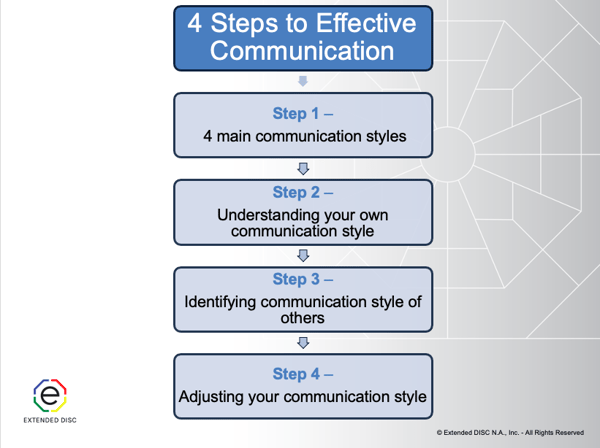 We tend to communicate in ways which are more comfortable for us. This may be similar or different from others. DISC states there is no better or worse style; only different. We all have strengths and challenges. In fact, the most successful people are the ones who use their strengths wisely and do not ignore their challenges. Their success is because of their keen self-awareness and knowing when to make adjustments.
We tend to communicate in ways which are more comfortable for us. This may be similar or different from others. DISC states there is no better or worse style; only different. We all have strengths and challenges. In fact, the most successful people are the ones who use their strengths wisely and do not ignore their challenges. Their success is because of their keen self-awareness and knowing when to make adjustments.
DISC helps us build self-awareness of our own style and how we show up to others. Are you open and chatty? Would you be surprised if others described you as someone who talks too much and is overly emotional?
DISC also helps you to identify the preferred communication style of others. Now, you have valuable information to make better decisions on how to adjust your style effectively.
Let's look at how each main style prefers to communicate and how to get your message across.
What are More Effective Ways to Get Your Message Across to D-styles?
D-styles are most comfortable when they are in control; dominating the interaction. They speak and you are expected to listen. When the roles are reversed, they tend to be impatient listeners. As an independent, task-focused style, they can ignore input from others. They are more direct; which can come across as blunt and insensitive to others who don't speak their language. D-styles express their opinions as facts; expecting no further discussion.
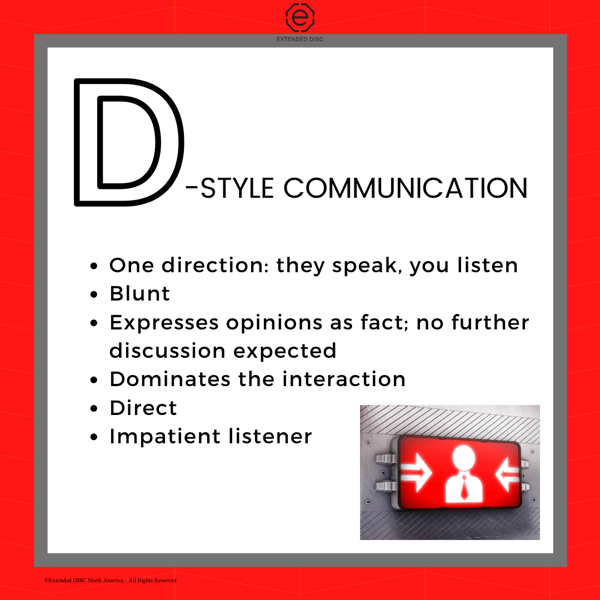 Here are some tips for speaking the D-style's language:
Here are some tips for speaking the D-style's language:
- Act quickly because they decide fast.
- Give them options so they feel they have the power to decide.
- Provide immediate feedback.
- Focus on results and quick action.
- Touch on highpoints; don't overuse data.
- Do not focus on emotions or be too chatty.
In this day and age, we are communicating more and more across a variety of platforms. DISC can help you better identify virtual styles of others.
When emailing D-styles, keep it succinct and action-oriented; just tell them what they need to know and identify a call to action. Remember, their responses will be more direct and exhibit a demanding tone; telling you instead of asking you. Use the phone if it is more efficient, but keep it brief and be prepared. Virtual meetings may not be preferred by D-styles because it can take more time. Remember, to keep it brief, clearly identify goals, and provide actionable next steps.
Who is Listening? Communicating Your Message to I-styles
We may assume communication is easier for I-styles, since they're naturally more social and talkative. However, it is not a given. DISC describes the I-styles behavioral preference for opportunities to interact with a variety of people. I-styles are charismatic and more focused on emotions over details and tasks. What DISC does not identify is their ability to communicate with people, only that they prefer to.
I-styles prefer avoiding unpleasant topics; preferring to focus on the positive. We often go to the I-style for positive feedback. However, they tend not to listen to details or for very long.
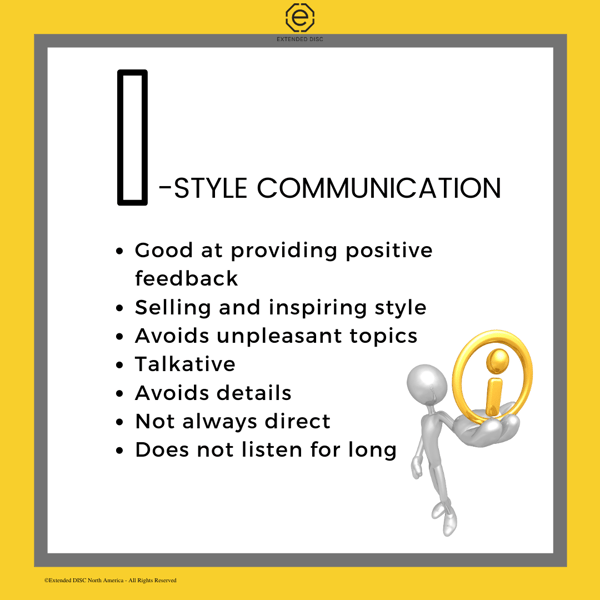 Here are some tips for communicating with an I-style:
Here are some tips for communicating with an I-style:
- Build in time to chat.
- Focus on the positive; try not to react negatively.
- Show enthusiasm.
- Let them speak.
- Focus more on them, rather than the tasks and details .
Don't overuse data or include too many details when emailing I-styles. Try to focus more on positivity and keep it friendly. Better yet, consider picking up the phone and calling them, but build in time to chat. I-styles respond well to live interactions such as phone calls and virtual meetings.
How S-styles Prefer to Communicate
S-styles prefer communication in one-on-one settings where trust is built. They are amiable and patient listeners, but will usually answer your questions only when asked. They want time to understand your perspective. S-styles tend to speak calmly and talk about topics that they're familiar with; usually in detail.
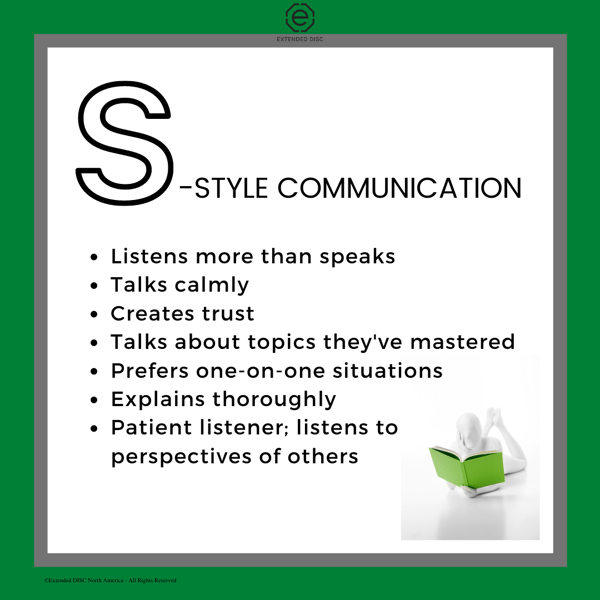 Some tips for interacting successfully with the S-profile:
Some tips for interacting successfully with the S-profile:
- Slow down and explain carefully.
- Allow time to think and talk about it with others.
- Build rapport and trust.
- Provide assurance and support.
- Don't make sudden changes.
- Keep your promises.
S-style emails tend to be friendly and well thought out. They may sign off with, “Best regards” or “Sincerely,” instead of "thanks!" S-styles are the team players of the styles so they are more likely to use the pronouns, “we” or “us” over “I” and “me." They are more likely to ask you to do something rather than tell you. S-styles seek information so they can make the best decision for their teams.
Try providing reassurance by answering their questions carefully, and progressing step-by-step. When emailing the S-style try using plural form when addressing them, “we” or “you and your team”. Also, be sincere and if possible, build rapport. Don’t push them into quick decisions and be sure to follow up and do what you agreed upon.
Why Your Message to C-styles May Not Be as Effective
C-styles prefer written communication; specifically, with a lot of details and fact-based information. They are more quiet, reserved, and diplomatic. C-styles may come across as timid because they tend not to speak or express disagreeing views. They are most comfortable discussing topics they have expertise with and avoid more abstract topics. They can be critical listeners, but so focused on details and correctness, they don't stand back and see the big picture.
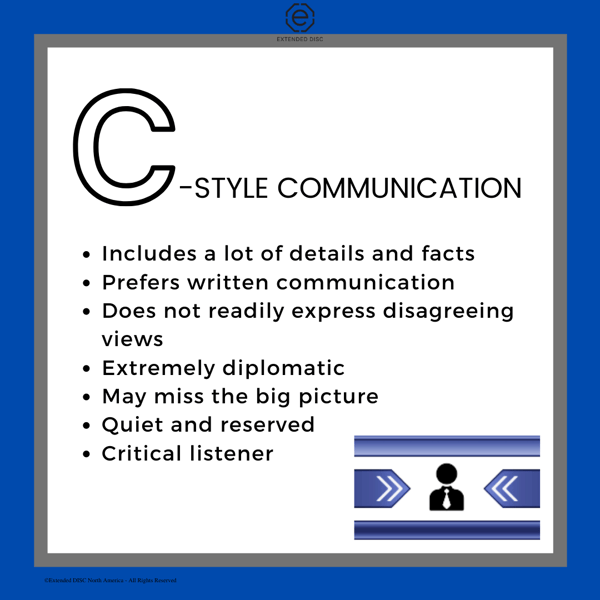 Tips for improving interactions with C-profiles:
Tips for improving interactions with C-profiles:
- Provide time to think and answer all of their questions.
- Explain carefully and give sound reasons and data whenever possible.
- Be patient with the details.
- Provide information; preferably in writing and ahead of time.
- Don't be too chatty.
C-styles prefer emails over face-to-face since they are naturally more reserved and more task-oriented. Their emails tend to be more detailed and formal. It is probably fact-checked and reviewed for punctuation so proofread your emails and answer their questions carefully or they will not be able to move forward. If you're calling or meeting virtually, try scheduling the call and letting them know what you'll be discussing ahead of time. Expect the C-style to be quieter, but provide them with opportunities to ask questions. Don't rush or move too quickly. Be sure to follow up and be prepared with supportive data.
Speaking the language of the styles
DISC reinforces our communication style; how it may be different from other styles. It also helps us better identify the style of others so we can communicate in a more common language. Ask yourself if you need to speed it up or slow it down, use bullet points, or pick up the phone in your next interactions. Simple adjustments can alleviate the frustrations and enhance the opportunity to get your message across. Both sides end up benefiting through the exchange of productive information.
